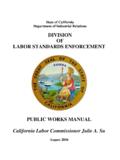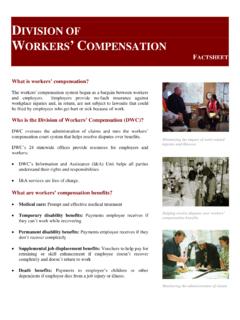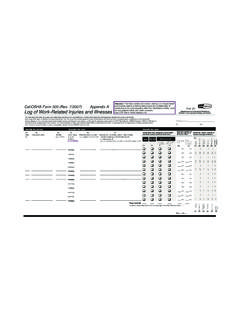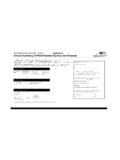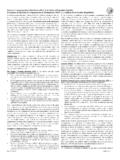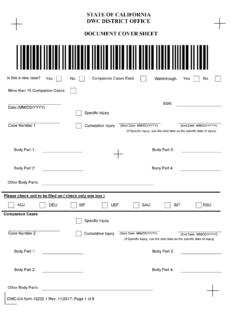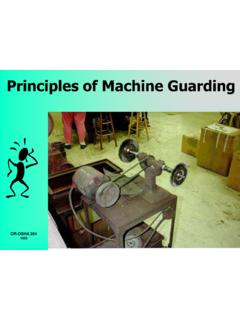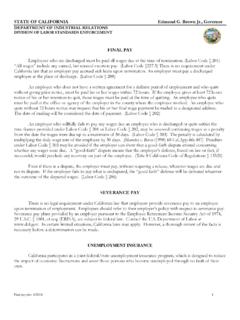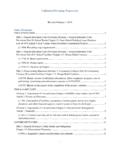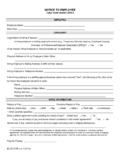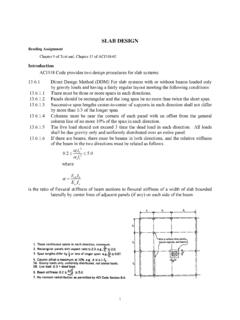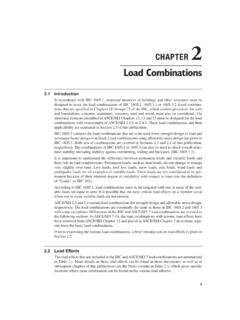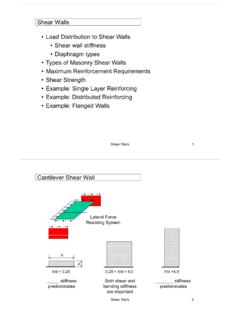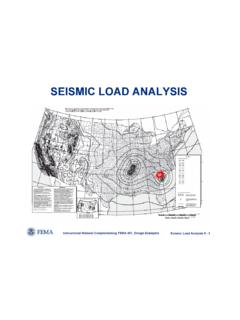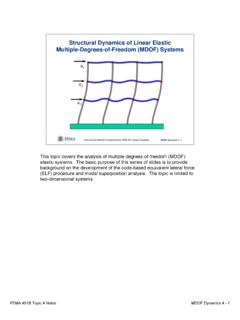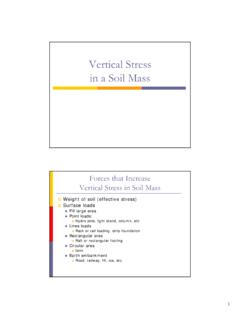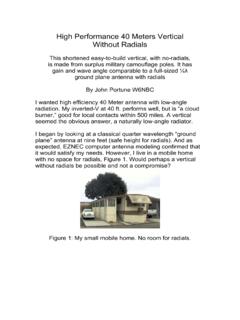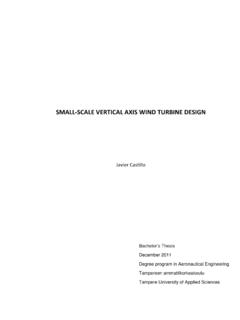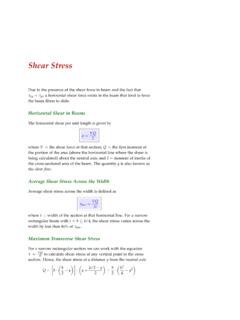Transcription of OPERATING RULES FOR INDUSTRIAL TRUCKS
1 LEFT (1/2 ) OPERATING RULES FOR INDUSTRIAL TR UCKS General Industry Safety Order 3664 OPERATING RULES (Part (a)) (a) Every employer using INDUSTRIAL TRUCKS or INDUSTRIAL tow tractors shall post and enforce a set of OPERATING RULES including the appropriate RULES listed in Section 3650 (t) . General Industry Safety Order 3650 INDUSTRIAL TRUCKS . General (Part (t )) (t) INDUSTRIAL TRUCKS and tow tractors shall be operated in a safe manner in accordance with the following OPERATING RULES : (1) Only drivers authorized by the employer and trained in the safe operations of INDUSTRIAL TRUCKS or INDUSTRIAL tow tractors pursuant to Section 3668 shall be permitted to operate such vehicles.
2 (2) Stunt driving and horseplay are prohibited. (3) No riders shall be permitted on vehicles unless provided with adequate riding facilities. (4) Employees shall not ride on the forks of lift TRUCKS . (5) Employees shall not place any part of their bodies outside the running lines of an INDUSTRIAL truck or between mast uprights or other parts of the truck where shear or crushing hazards exist. (6) Employees shall not be allowed to stand, pass, or work under the elevated portion of any INDUSTRIAL truck , loaded or empty, unless it is effectively blocked to prevent it from falling. (7) Drivers shall check the vehicle at the beginning of each shift, and if it is found to be unsafe, the matter shall be reported immediately to a foreman or mechanic, and the vehicle shall not be put in service again until it has been made safe.
3 Attention shall be given to the proper functioning of tires, horn, lights, battery, controller, brakes, steering mechanism, cooling system, and the lift system for forklifts (forks, chains, cable, and limit switches). (8) No truck shall be operated with a leak in the fuel system. (9) Vehicles shall not exceed the authorized or safe speed, always maintaining a safe distance from other vehicles, keeping the truck under positive control at all times and all established traffic regulations shall be observed. For TRUCKS traveling in the same direction, a safe distance may be considered to be approximately 3 truck lengths or preferably a time lapse - 3 seconds - passing the same point. General Industry Safety Order 3650 INDUSTRIAL TRUCKS .
4 General (Part (t )) (10) TRUCKS traveling in the same direction shall not be passed at intersections, blind spots, or dangerous locations. (1 1) The driver shall slow down and sound the horn at cross aisles and other locations where vision is obstructed. If the load being carried obstructs forward view, the driver shall be required to travel with the load trailing. (12) Operators shall look in the direction of travel and shall not move a vehicle until certain that all persons are in the clear. (13) TRUCKS shall not be driven up to anyone standing in front of a bench or other fixed object of such size that the person could be caught between the truck and object. (14) Grades shall be ascended or descended slowly.
5 (A) When ascending or descending grades in excess of 10 percent, loaded TRUCKS shall be driven with the load upgrade. (B) On all grades the load and load engaging means shall be tilted back if applicable, and raised only as far as necessary to clear the road surface. (C) Motorized hand and hand/rider TRUCKS shall be operated on all grades with the load -engaging means downgrade. (15) The forks shall always be carried as low as possible, consistent with safe operations. (16) When leaving a vehicle unattended (the operator is over 25 feet ( meters) from or out of sight of the INDUSTRIAL truck ), the brakes are set, the mast is brought to the vertical position, and forks are left in the down position, either: (A) The power shall be shut off and, when left on an incline, the wheels shall be blocked; or (B) The power may remain on provided the wheels are blocked, front and rear.
6 (17) When the operator of an INDUSTRIAL truck is dismounted and within 25 feet ( meters) of the truck which remains in the operator s vie w, the load engaging means shall be fully lowered, controls placed in neutral, and the brakes set to prevent movement. Continued in the next OPERATING RULES FOR INDUSTRIAL TRUCKS General Industry Safety Order 3650 INDUSTRIAL TRUCKS . General (Part (t)) Exception: Forks on fork -equipped INDUSTRIAL TRUCKS may be in the raised position for loading and unloading by the operator if the forks are raised no more than 42 inches above the same level on which the INDUSTRIAL truck is located, the power is shut off, controls placed in neutral and the brakes set.
7 If on an incline, the wheels shall be securely blocked. Whenever the forks are raised, the operator will remain in the seat of the INDUSTRIAL truck except when the operator is actively loading or unloading materials. (18) Vehicl es shall not be run onto any elevator unless the driver is specifically authorized to do so. Before entering an elevator, the driver shall determine that the capacity of the elevator will not be exceeded. Once on an elevator, the INDUSTRIAL truck s power shall be shut off and the brakes set. (19) Motorized hand TRUCKS shall enter elevators or other confined areas with the load end forward. (20) Vehicles shall not be operated on floors, sidewalk doors, or platforms that will not safely support the loaded vehicle.
8 (21) Prior to driving onto TRUCKS , trailers and railroad cars, their flooring shall be checked for breaks and other structural weaknesses. (22) Vehicles shall not be driven in and out of highway TRUCKS and trailers at loading docks until such TRUCKS or trailers are securely blocked or restrained and the brakes set. (23) To prevent railroad cars from moving during loading or unloading operations, the car brakes shall be set, wheel chocks or other recognized positive stops used, and blue flags or lights displayed in accordance with Section 3333 of these Orders and Title 49, CFR, Se ction which is hereby incorporated by reference. (24) The width of one tire on the powered INDUSTRIAL truck shall be the minimum distance maintained from the edge by the truck while it is on any elevated dock, platform, freight car or truck .
9 (25) Railroad tracks shall be crossed diagonally, wherever possible. Parking closer than 8 1/2 feet from the centerline of railroad tracks is prohibited. (26) TRUCKS shall not be loaded in excess of their rated capacity. (27) A loaded vehicle shall not be moved until the load is safe and secure. General Industry Safety Order 3650 INDUSTRIAL TRUCKS . General (Part (t)) (28) Extreme care shall be taken when tilting loads. Tilting forward with the load engaging means elevated shall be prohibited except when picking up a load . Elevated loads shall not b e tilted forward except when the load is being deposited onto a storage rack or equivalent. When stacking or tiering, backward tilt shall be limited to that necessary to stabilize the load .
10 (29) The load engaging device shall be placed in such a manner that the load will be securely held or supported. (30) Special precautions shall be taken in the securing and handling of loads by TRUCKS equipped with attachments, and during the operation of these TRUCKS after the loads have been removed. (31) When powered INDUSTRIAL TRUCKS are used to open and close doors, the following provisions shall be complied with: (A) A device specifically designed for opening or closing doors shall be attached to the truck . (B) The force applied by the device to the door shall be applied parallel to the direction of travel of the door. (C) The entire door opening operation shall be in full view of the operato r.
